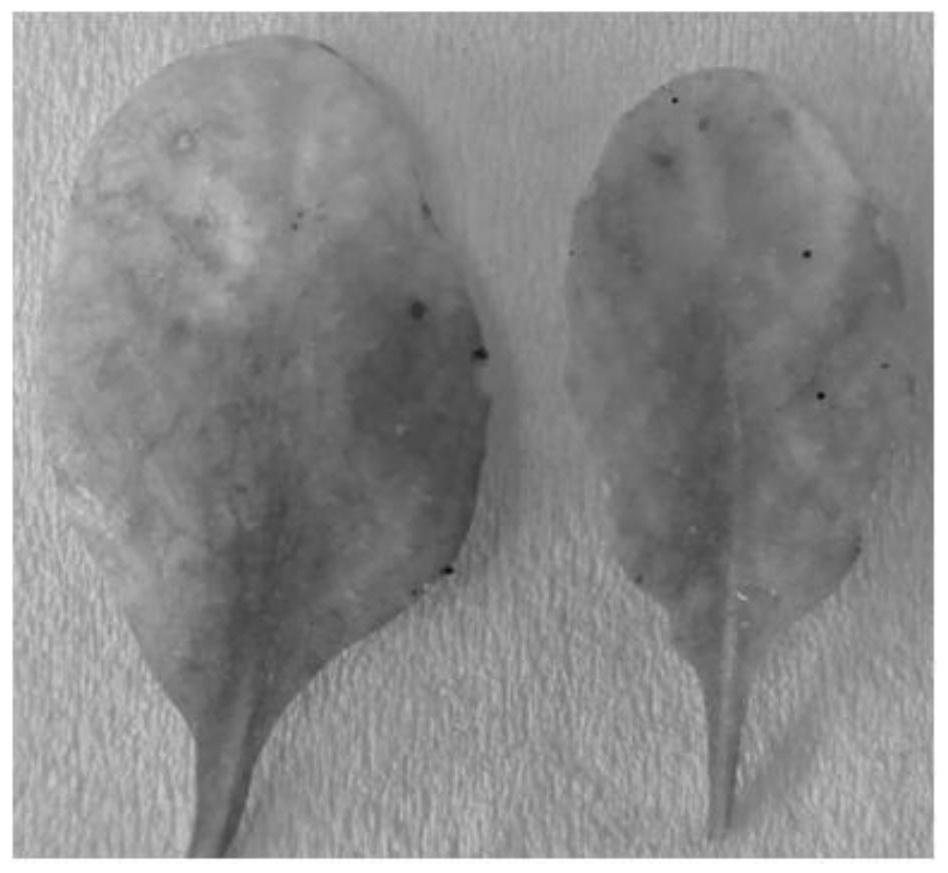Application of arabidopsis transcription factor AT3G46090 gene in cultivation of disease-resistant transgenic plants
A technology of AT3G46090, transgenic plants, applied in the field of genetic engineering, can solve the problems of secondary pollution and ecological harm, and achieve the effect of enhancing disease resistance
- Summary
- Abstract
- Description
- Claims
- Application Information
AI Technical Summary
Problems solved by technology
Method used
Image
Examples
Embodiment 1
[0012] Example 1 Obtaining the Gene Sequence of the Arabidopsis Transcription Factor AT3G46090 and Construction of the Plant Expression Vector.
[0013] Log in to the Arabidopsis information resource database website https: / / www.arabidopsis.org / servlets / TairObject? type=sequence&id=30046, find the sequence (SEQ ID No.1) of the transcription factor AT3G46090 gene, design PCR amplification primers according to the CDS of the AT3G46090 gene,
[0014] AT3G46090-F:5'-ATGGTTGCGAGAAGTGAGGAA-3'
[0015] AT3G46090-R:5'-TTAACTCCAAGAAATCGTTCT-3'
[0016] The wild-type Arabidopsis Col-0 was cultivated, and the leaves of Arabidopsis thaliana grown for 3 weeks under short-day sunlight were taken as materials. The total plant RNA was extracted by TRIzol method, and the cDNA was obtained by reverse transcription PCR, and then the target sequence was amplified using the cDNA as a template.
[0017] The specific steps for extracting RNA are as follows: Grind the leaves of Arabidopsis thaliana...
Embodiment 2
[0020] The acquisition of embodiment 2 transgenic Arabidopsis plants
[0021] Firstly, the plants are cultivated to the flowering stage, and then transformed with the Agrobacterium dipping method, and the transgenic plants are screened after the seeds are harvested.
[0022] The method of plant cultivation:
[0023] Take enough Arabidopsis seeds and put them into centrifuge tubes for surface disinfection. First surface disinfection with 75% ethanol for 30s, rinse once with sterile water, then surface disinfection with 1% NaClO for 5-8min, rinse with sterile water three times; after surface disinfection is completed, sow the treated seeds in 1 / 2MS culture base plate. Seal the spot plate with parafilm and place it in the dark at 4°C. After 2-4 days, the plates were placed in a plant light incubator (the light cycle was 12h light / 12h dark). Eight days after the seeds germinated, the Arabidopsis seedlings were transferred to nutrient soil, grown under the same light conditions...
Embodiment 3
[0028] Example 3 Verification of transgenic Arabidopsis
[0029] Genomic DNA was extracted from the leaves of transgenic plants and verified by PCR to confirm that the AT3G46090-flag DNA fragment was inserted into the Arabidopsis genome.
[0030] Genomic DNA extraction:
[0031] Take 50 mg of normal growing Arabidopsis leaves to be tested and add 400 μL of plant genomic DNA extract (200 mM Tris-Cl pH7.4, 250 mM NaCl, 25 mM EDTA, 1% SDS) after grinding, vortex and mix well, and centrifuge at high speed for 5 min. Aspirate the supernatant and add an equal volume of isopropanol, precipitate at room temperature for 30 minutes, discard the supernatant after high-speed centrifugation for 5 minutes, wash the precipitate twice with 70% ethanol, and dissolve the precipitate in 20 μL of nuclease-free ddH 2 O.
[0032] Use the specific primers of pGWB11 vector for PCR amplification:
[0033] PCR was performed using the above-mentioned extracted genomic DNA as a template, and the syste...
PUM
 Login to View More
Login to View More Abstract
Description
Claims
Application Information
 Login to View More
Login to View More - R&D
- Intellectual Property
- Life Sciences
- Materials
- Tech Scout
- Unparalleled Data Quality
- Higher Quality Content
- 60% Fewer Hallucinations
Browse by: Latest US Patents, China's latest patents, Technical Efficacy Thesaurus, Application Domain, Technology Topic, Popular Technical Reports.
© 2025 PatSnap. All rights reserved.Legal|Privacy policy|Modern Slavery Act Transparency Statement|Sitemap|About US| Contact US: help@patsnap.com



